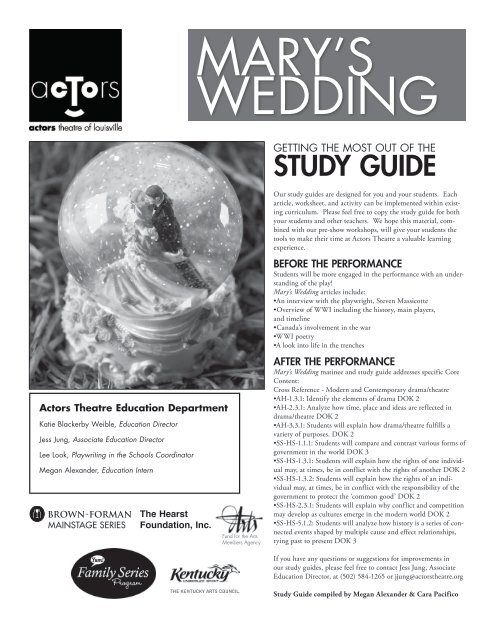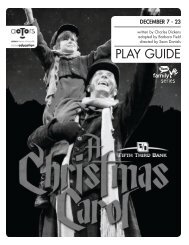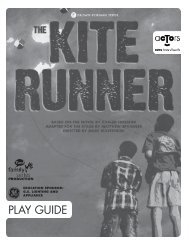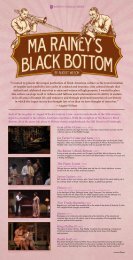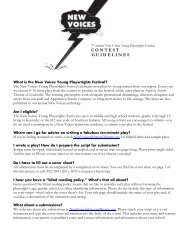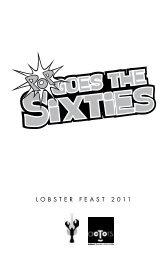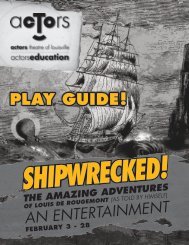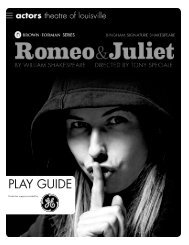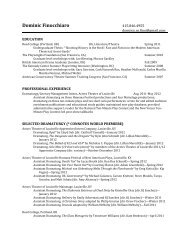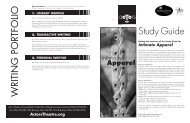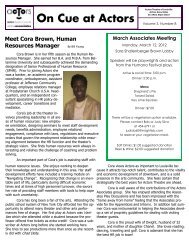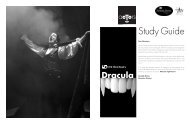Mary's Wedding Play Guide - Actors Theatre of Louisville
Mary's Wedding Play Guide - Actors Theatre of Louisville
Mary's Wedding Play Guide - Actors Theatre of Louisville
- No tags were found...
You also want an ePaper? Increase the reach of your titles
YUMPU automatically turns print PDFs into web optimized ePapers that Google loves.
From the <strong>Play</strong>wrightAn Interview with Stephen MassicotteIn recent years Stephen’s plays A Farewell to Kings, Sherlock Holmes, Looking AfterEden and the popular Star Wars inspired Boy’s Own Jedi Handbook series have playedfor audiences throughout Canada. In 2002 his play Mary’s <strong>Wedding</strong> premiered atAlberta <strong>Theatre</strong> Projects’ annual playRites Festival and was the winner <strong>of</strong> the 2000Alberta <strong>Play</strong>writing Competition, the 2002 Betty Mitchell Award for Best New <strong>Play</strong>and the 2003 Alberta Book Award for Drama. Washington DC’s <strong>Theatre</strong> Allianceproduction <strong>of</strong> Mary’s <strong>Wedding</strong> received seven Helen Hayes Award nominationsand the play continues to be produced in English and French throughout Canada,the United States and the United Kingdom. Stephen’s play The Last Seduction <strong>of</strong>Giacomo Casanova won the 24 Hour <strong>Play</strong>writing Competition at Alberta <strong>Theatre</strong>Projects and his play Pervert (now retitled The Dirty/Beautiful) won the 2004 BettyMitchell Award for Best New <strong>Play</strong> in the fall. Also, his play The Emperor <strong>of</strong> Atlantispremiered in conjunction with Viktor Ullman’s opera Der Kaiser Von Atlantis as a coproductionbetween Workshop West <strong>Theatre</strong> and the Edmonton Opera. Stephen’splay The Oxford Ro<strong>of</strong> Climber’s Rebellion, a play about T.E.Lawrence and RobertGraves, just received its premiere at Toronto’s Tarragon <strong>Theatre</strong>. He also has beencommissioned by The Stratford Festival <strong>of</strong> Canada to create a new play for that prestigioustheatre. Stephen’s film writing credits include the screenplays for the featurefilms Ginger Snaps Back: The Beginning and The Dark.Merv Antonio (Dramaturg and Director <strong>of</strong> New <strong>Play</strong>Development) : What inspired you to write MARY’SWEDDING?Stephen Massicotte: I’ve always wanted to be a history teacher andwhen I was growing up attending Remembrance Day, (the November 11 thequivalent <strong>of</strong> Memorial Day or Veteran’s Day), with my Grandfather wasmandatory. My brothers and I used to go door to door selling poppies, soI’ve always had an awareness <strong>of</strong> Canada’s military history. In UniversityI saw the Calgary Stampede Parade for the first time (which is a big dealup here) and saw the Lord Strathcona’s Horse Regiment historical reenactmentriding team. I picked up a book about them and found that they’dparticipated in some <strong>of</strong> the last cavalry charges in military history. TheCharge at Morieul Wood was the starting point for the play. A coupleyears back on a visit to France I was actually able to visit Morieul Woodand found shells craters and slit trenches still visible to the eye. I als<strong>of</strong>ound rusted artillery shell casings and some unfired rifle rounds.MA: What events, books, images, sounds, etcinfluenced you in the creation <strong>of</strong> this work?SM: There’s a regimental history written about the Strathcona’s in theFirst World War called Stand to Your Horses written by S. H. Williamsthat was instrumental in writing the play. Hemingway’s For Whom theBell Tolls and Robert Graves’ book Goodbye to All That were both veryhelpful because they both experienced the war first hand but were alsogreat writers in their own right. Goodbye to All That also became thesource for my next historical play, as Graves describes his friendship withLawrence <strong>of</strong> Arabia in it. I dramatized their relationship in my play TheOxford Ro<strong>of</strong> Climber’s Rebellion. Oddly enough, Kurt Vonnegut’s bookSlaughterhouse Five was very influential on Mary’s <strong>Wedding</strong>… I tried toemulate the tone <strong>of</strong> pity and compassion for the human race that’s in thatbook. Also the fact that Vonnegut tells you right from the start how thestory ends but rather than diminishing the suspense it actually increases it.And there is a song by Sinead O’Connor called In The Heart that I playedover and over while writing the play.MA: How did you decide on the dream-like andepistolatory structure for the play?SM: That came about in the trial and error efforts <strong>of</strong> writing the play. Itried writing it in about a half dozen or more different styles <strong>of</strong> theatre…narrator driven with flashbacks, a letter driven play, a realistic play similarto the traditional fourth wall style etc. I found because <strong>of</strong> the size <strong>of</strong> thestory I was trying to tell none <strong>of</strong> those styles could carry the play past pagetwelve or so. I wanted it to be a really intimate but with a back drop as bigas the biggest Hollywood movie. Finally, I started taking bits and piecesfrom all the different versions and putting them together ‘til I had abouttwenty pages and then I wrote on from there. It was a matter <strong>of</strong> sayingyes to the play that the play wanted to be.MA: Are Mary, Charlie and Flowers based on historicalfigures?SM: Mary and Charlie are technically fictional but Gordon MurielFlowerdew was a real soldier and was awarded the Victoria Cross (theBritish Commonwealth equivalent <strong>of</strong> the Congressional Medal <strong>of</strong> Honor)for actions as described in the play. All the battles and historical events asdescribed in the play are fact. However, I’ve had a lot <strong>of</strong> folks come up tome after performances <strong>of</strong> the show and tell me that Mary’s story is theirmother’s or their grandmother’s story. The names are significant. Maryis the mother <strong>of</strong> Jesus, Mhairi’s <strong>Wedding</strong> is a traditional Highland song,Chalmers was the last name <strong>of</strong> the girl (Fiona) I was in love with that livednext door to us when I was in grade three. Charlie was a nickname a girlfriendhad for me, and Edward is the name <strong>of</strong> my favorite cousin.MA: What do you hope the audiences walk away withafter seeing the play?SM: I hope they go home exhausted. Some theatre people say they wantto make people think while they watch the show. I don’t at all. I wantthem to have a good laugh and good cry and a shock or two while they’rewatching the show. For the next week or two, that’s when I want themto think. Also, I want them to tell their friends. Audiences don’t realizehow powerful their feelings and opinions are. If after every show they seethey convinced one other person to go check it out, the amount <strong>of</strong> theatrein North America could double.
Repercussions What might have been a nationalist conflict between twosmall countries develops into a full fledged world war. Germany gives Austria-Hungary a “blank check” in support <strong>of</strong> any action they take against Serbia, ineffect pushing them to declare war. Russia immediately goes to defend Serbia,with France not far behind. Germany, in an attempt to invade French territory,invades neutral Belgium. Great Britain sees this as a power threat and entersthe war against Germany. Thus the beginning <strong>of</strong> the First Great War.Causes <strong>of</strong> THEGreat WarMuch like a volcano, this war startedwith seemingly insignificant events rumblingbeneath the surface. However,with a strengthening loyalty <strong>of</strong> alliances,and a drive for imperialism, thesecontained conflicts exploded into one<strong>of</strong> the greatest wars in history.BOOM! Franz Ferdinand; heir to Austria-Hungary’sthrone, is assassinated by Serbian nationalist, June28, 1914. The assassin, Gavrilo Princip, had manyaccomplices, all <strong>of</strong> whom were under the age <strong>of</strong> 27.Picking Fights: Meanwhile in Africa…Morocco, a British colony given toFrance, was being prompted by the Germans to demand their independence. Francedecides to make Morocco a protectorate. Germany facilitates Morocco’s independenceonce again, and only backs <strong>of</strong>f in exchange for land in the French Congo. … in Bosnia… Austria-Hungary and Serbia both want to annex Bosnia. Russia mobilizes in support <strong>of</strong>Serbia, while Germany mobilizes to support Austria-Hungary. Russia backs down to preventa full out war. But tensions are high.Arms Race: The German military is substantially powerful and very organized. During this time theFrench, British, and German armies and navies grow exponentially in a race to out arm the other alliance.Alliances: Prussian leader, Otto von Bismarck; is driven to make Prussia the most powerful country in theGerman Confederation. He forms an alliance with Russia, Austria-Hungary, and Germany in 1872, named theThree Emperor’s League. In response to French occupation in Italy, Bismarck forms the Triple Alliance comprised <strong>of</strong>Italy, Germany, and Austria-Hungary in 1882. Because <strong>of</strong> previous conflicts, Russia distrusts Austria-Hungary and isweary <strong>of</strong> joining an alliance with them. In 1890, Bismarck is thrown out <strong>of</strong> power by Kaiser William II <strong>of</strong> Germany.Russia is displaced from the alliances with Germany due to a general dislike <strong>of</strong> Slavs. France then joins with Russiain 1894, forming the Franco-Russian Entente. Great Britain grows suspicious <strong>of</strong> Germany’s military power and unitesallied with France, to which Russia also pledged support, forming the Triple Entente in 1907.Imperialism: Great Britain, France, and Germany each want to expand their foreign markets, following the increase inproduction from the Industrial Revolution. They all see opportunity in Africa. Britain and France cooperate with each other, butGermany proves more stubborn. In the Middle East, the Ottoman Empire is crumbling, giving Russia, the Balkans, and Austria-Hungaryopportunity for their own expansion.Nationalism: In 1815, following the downfall <strong>of</strong> Napoleon I, the Congress <strong>of</strong> Vienna divides Germany and Italy in favor <strong>of</strong> peace. Theysubsequently unify in 1861 and 1871 respectively, with a great sense <strong>of</strong> nationalism. The French who had lost Alsace-Lorraine to Germany in theFranco-Prussian war hold on to a bitter grudge. Austria-Hungary and the Balkans are presently comprised <strong>of</strong> various conflicting national groups.
Timeline <strong>of</strong> Major World War I Events.191428 June Archduke Franz Ferdinand and Archduchess Sophie <strong>of</strong>Austria-Hungary are assassinated in Sarajevo, by Gavrilo Princip.28 July Austria-Hungary declares war against Serbia.1-10 August Germany declares war against Russia, France,and Belgium; Great Britain declares war against Germany; Francedeclares war against Austria-Hungary.5 September First Battle <strong>of</strong> the Marne, where the French held theGermans and sent them into retreat.15 November First Battle <strong>of</strong> Ypres ends with massive losses on allsides.25 December An un<strong>of</strong>ficial truce on Christmas day. German andBritish troops sing songs and exchange gifts instead <strong>of</strong> bombs.191519 February Allies begin naval campaign <strong>of</strong> eighteen battleshipsto open the German blockade <strong>of</strong> the Dardanelles.10 March British Expeditionary Force launches an <strong>of</strong>fensive atNeuve Chapelle.8 April Armenian genocide by the Ottoman forces.22 April Germans open on the Second Battle <strong>of</strong> Ypres with a newweapon in hand, chlorine gas. The Canadians play a huge role inthis battle, though they suffer greatly for it as well.26 April Italy joins the Allied side, in betrayal <strong>of</strong> the Triple Alliancewith Germany.7 May The Lusitania is torpedoed and sunk by Germansubmarines, killing 1,000, <strong>of</strong> whom 128 were American.191626 February The Battle <strong>of</strong> Verdun is progressing with heavy beatingsby the Germans, but the French refuse to step down.22 June Germans introduce the even deadlier, phosgenegas at Verdun.1 July Allied <strong>of</strong>fensive on the Somme River begins.19 November The Battle <strong>of</strong> the Somme ends with over 600,000casualties on each side.22 December Germans end their strategy <strong>of</strong> attrition againstVerdun, with over 300,000 casualties on either side, this was theongest battle in history.19171 March The Zimmerman Telegram, sent by the German foreignminister to Mexico, proposing an alliance should the U.S. enter thewar, was revealed to the American public.7 April The United States declares war on Germany.12 April Canadians face fierce gunfire and harsh conditions, yetcapture Vimy Ridge against the Germans sending them into retreat.11,297 Canadians are killed or wounded.6 July T.E. Lawrence and a band <strong>of</strong> Howeitat tribesmen capture theArab city <strong>of</strong> Aqaba after a two-month march across the desert.31 July The Third Battle <strong>of</strong> Ypres, “Passchendaele,” begins.Ending in November, this Allie gain was won by the charge <strong>of</strong> theCanadian troops.19188 January U.S. President Woodrow Wilson announces his“Fourteen Points” as a means to peace.30 March Canadian Calvary Brigade is victoriousat Moreuil Wood.16 July Tsar Nicholas <strong>of</strong> Russia and his family are murderedby the Bolsheviks.3 October Prince Max, the new German chancellor, acceptsWilson’s Fourteen Points. Austria-Hungary does the same four dayslater.11 November The Armistice is signed in Paris. Kaiser Wilhem II <strong>of</strong>Germany and Karl I <strong>of</strong> Austria-Hungary abdicate their thrones.The War has ended.191928 June Germany signs the Treaty <strong>of</strong> Versailles.http://www.bbc.co.uk/history/worldwars/wwone/launch_ani_western_front.shtmlUse this website to further understand the events on theWestern Front. Includes animated slide show presentation.
Life in The TrenchesWWI was a long and hard war. It was a war<strong>of</strong> attrition. It was not fought through battles<strong>of</strong> quick victory over the enemy. Instead thewar was won by those who managed to survivethe longest. This is not to say there were notparticular battles <strong>of</strong> great courage and bravery.There were, but the reality <strong>of</strong> the war lies withinthe makeshift walls <strong>of</strong> the trenches, and in theminds and souls <strong>of</strong> the men who lived insidethem.The war was projected by both sides to onlylast a short while. The Germans had a strategicplan known as the Schlieffen Plan that wouldtake Paris, then St. Petersburg in one quicksweep before anyone could react. However, thenew weaponry introduced into the war quicklyinterrupted the German’s plan and brought anonset <strong>of</strong> unforeseen horror and death. When theGerman advance into France failed at the riverMarne, a stalemate ensued. Trenches were dug[ ]“The rats were huge.They were so big they wouldeat a wounded man if hecouldn’t defend himself.”all along the Western front on both sides, fromthe Swiss Alps to the English Channel.The Ally trench system was typified by fourmain types <strong>of</strong> trenches. The first in line <strong>of</strong> battlewere the Front Line trenches. Located only 50yards from enemy lines they were extremelyvulnerable to enemy fire, but were also positionedwell to attack. The second line was theSupport trench which was a few hundred yardsbehind the front lines and held reserve soldiersand supplies. The third line was the Reservetrench with emergency supplies, <strong>of</strong>ficers, andmore soldiers. Connecting the trenches was aseries <strong>of</strong> Communication trenches. These smallnarrow trenches were used to move supplies andmessages back and forth, as well as allow forreconnaissance. The soldiers typically wererotated through the first three lines <strong>of</strong> trenches,spending one week in each station. The Alliedtrenches were usually open-air spaces, fortifiedwith planks <strong>of</strong> wood, rocks, sandbags, or whateverthey could find.The German trenches were quite different.They developed highly sophisticated and complexstructures, <strong>of</strong>ten including undergroundtunnels and reinforced trenches. Many <strong>of</strong> thehigher ranks had the luxuries <strong>of</strong> electricity,plumbing, mattresses, wall paper, and carpetedfloors in their bunkers. Although it seems morecomfortable than the Allies’ situation, trenchlivingwas never a preferable lifestyle.On average 7,000 men from each side werewounded, disabled, orkilled in the trenches eachand every day.The open land betweenthe opposing sides wasknown as No Man’s Land.Continuous bombing createda barren space withlittle to no vegetation, coveredinstead by craters, shrapnel, and corpses. Itwas a very dangerous place for a soldier to be,putting him in plain sight <strong>of</strong> the enemy. For thisreason, most <strong>of</strong> the fighting occurred at night.It was then that soldiers could attempt to sneakto the other side to spy on the enemy and firesurprise attacks.Daily life in the trenches was miserable. It wasfreezing cold at times, scorching hot at others.The rain caused the trenches to flood, soakingthe soldiers’ supplies. As soldiers moved fromlocation to location they each carried with themover 60lbs <strong>of</strong> supplies on their backs, and whenwet that weight could double. The rain also gaveway to the curse <strong>of</strong> trench foot. This condition,similar to frostbite, was caused by the long hours<strong>of</strong> standing in wet soppy boots. The infectedfoot would go numb, turn red or blue, and possiblyturn gangrene, forcing an amputation. Thesoldiers were eventually ordered to change socksthree times a day to prevent trench foot.Nothing was pleasant in the trenches. Sanitaryconditions were crude at best. The smell <strong>of</strong>putrefaction, mildew, and gas was constant.Rats overran the trenches, feasting on corpsesand growing to the size <strong>of</strong> cats. One soldierreported, “The rats were huge. They were so bigthey would eat a wounded man if he couldn’tdefend himself.” Lice consumed the bodies<strong>of</strong> the soldiers as they itched compulsively toremove the disease carrying vermin. Nits infestedthe men’s hair, and flies were everywhere.The food was spoiled and sparse. Aside from thephysical damages, men’s minds <strong>of</strong>ten went astrayfrom the impact <strong>of</strong> shell-shock, a term used todescribe the mental stress caused by intense fear,claustrophobia, and constant sight <strong>of</strong> death themen experienced.Serving on the Western Front was not justabout avoiding being shot or blown up. It was astruggle for survival against nature, their fellowsoldiers, and their own mentality.It is estimated that 50% <strong>of</strong> WWI casualtieswere attributed to the foul life in the trenches.ACTIVITYGo to http://www.bbc.co.uk/schools/worldwaronefor games, activities, and interactive informationabout trench warfare, soldiers’ letters, andthe Homefront. You can plan your own trenchwarfare missions and see if you are successful, orsee what causes you to fail.
WWI WeaponsNew technology and science gave way to a newkind <strong>of</strong> war. With advancements in the machinegun, artillery, and developments in the use <strong>of</strong>gas weaponry, new strategies <strong>of</strong> both defenseand <strong>of</strong>fense had to be applied. The war becameone <strong>of</strong> attrition in which the men died out longbefore their ammunition did.Bayonets were issued to every soldier inWorld War One. A bayonet is essentially a bladesecured to the end <strong>of</strong> a rifle, used primarily inclose combat. The French preferred a needlebayonet, while many Germans used a saw-likebayonet. The English primarily stuck to thestandard knife variety.Machine Guns soon took over the bayonetas the lead weapon in WWI. First invented byHiram Maxim in 1884, it was the first automatic,continuous, portable firing weapon. Itcould fire between 400-600 rounds <strong>of</strong> ammunitionper minute, equaling the combined power<strong>of</strong> 100 rifles. It took three to six men to crewthe machine which usually was positioned on atripod. Machine guns were used by both sidesin the war and were despised by the vulnerableinfantry who could be gunned down in a downpour<strong>of</strong> bullets.Artillery describes the large-caliber mountedfirearms used in war. Light artillery refersto solid shots <strong>of</strong> 4-6 pounds, while heavy artilleryrefers to those weighing 8-12 pounds. TheHowitzer and mortar were two <strong>of</strong> the mostcommonly used heavy artillery weapons. Theyfired heavy shells on a high trajectory througha fairly short barrel, making them efficient intheir purpose. By the end <strong>of</strong> the war some <strong>of</strong>these machines could fire shells weighing over900kg up to 18km. One major concern for theseweapons was that they were heavy, and had tobe modified in order to be trucked through themud and shattered ground.Grenades were originally hollow iron ballsfilled with gunpowder and ignited by a slowburning match. To be effective they had to bethrown over 100ft. At the start <strong>of</strong> WWI theyused a stick grenade which was more effectivebut still had a short trajectory, proving dangerousfor the men in the front line trench who were<strong>of</strong>ten hit by friendly fire. In 1915, the Britishinvented the Mills Bomb. Once the grenadewas in the air, the lever flew up and releasedthe striker, which ignited a four-second timefuse, allowing the thrower to take cover beforeit exploded. When the grenade went <strong>of</strong>f, thecast-iron casing shattered producing a shower <strong>of</strong>metal fragments. The Mills Bomb was adaptedto be fired from a rifle sending the grenadeover 600ft. Over 33 million Mills Bombs weredeployed by the British troops alone.Armored Cars were fortified open-toppedvehicles with machine guns or other artillerymounted to them. The most popular Allycar was the Napier produced in 1912. TheArmored cars had little use on the tough terrain<strong>of</strong> the Western Front, but were very successfulin Palestine and in Mesopotamia where theywere deployed in what had previously been theCavalry role <strong>of</strong> outflanking and pursuit.Tanks did the job <strong>of</strong> what the armoredcars could not. In the United States, the HoltCompany built a tractor with caterpillar tracksthat was used to move over difficult territory.The machine could successfully cut thoughbarbed wire, and was fitted with revolvingmachine guns. Built under top secrecy, thetractor was given the code-name “tank” by theBritish Colonel Swinton. The WWI tank wasslow and could not cross over the broad trenches,making it inefficient for this war, however it continuedto be redesigned and was an indispensablepart <strong>of</strong> WWII.Gas attacks discharged from bombs or cylindersand carried by the wind, <strong>of</strong>ten began in themorning hours when the cold air would maintainthe weapon’s power keeping it low to theground. The Germans were the first to use gasat the Second Battle <strong>of</strong> Ypres on April 22, 1915.The French, having no idea what giant cloud<strong>of</strong> green mist was, fled in fear. Soon gas wasbeing used on both sides. Chlorine gas was verycommonly used and would cause asphyxiationand a slow death. Mustard gas also became verypopular. Contact with this gas led to the rotting<strong>of</strong> the body, blisters, blindness, nausea and deterioration<strong>of</strong> the bronchial tubes. To combat theattacks, men used urine soaked cloth as means<strong>of</strong> neutralizing the chlorine gas. Later gas maskswere developed covering the eyes, mouth, andnose with neutralizing chemicals. These maskswere bulky, uncomfortable, and did not protectthe men from the psychological fear <strong>of</strong> gas.Connections1. How did the new technology <strong>of</strong> the warchange the way in which soldiers fought andleaders strategize?2. How did the psychology <strong>of</strong> war change?What were the effects <strong>of</strong> trench life, gas,heavy artillery, and the presence <strong>of</strong> no-man’slandon the soldiers?3. Imagine yourself as a soldier in the trenches.Why are you there? Is it duty to your country, respect for your family, loyal patriotism,or some other reason? Imagine yourenvironment. What is above, below, andnext to you? Write a diary entry describingyour first impressions <strong>of</strong> trench life.
A CONTINENT AWAYWhy Canadians Felt a Need to FightWhen the historian <strong>of</strong> the future comes to analyze the events which made it possible for the Empire to stand like this, he willsee that there must have been some overmastering impulse contributing to this wonderful result.One such impulse is to be found in the love <strong>of</strong> the liberty, the pursuit <strong>of</strong> ideals <strong>of</strong> democracy, and the desire anddetermination to preserve the spirit <strong>of</strong> unity founded on those ideals, which make the whole Empire united in aim and singlein purpose. But there was, also, in all the Overseas Dominions, the intense conviction that this war was forced upon theEmpire—that we could not with honour stand aside and see trampled underfoot the liberties and independence <strong>of</strong> a weakand un<strong>of</strong>fending nation whose independence we had guaranteed. And, above and beyond all that, was the realization <strong>of</strong>the supreme truth—that the quarrel in which we are engaged transcends even the destinies <strong>of</strong> our own Empire and involvesthe future <strong>of</strong> civilization and <strong>of</strong> the world.-Prime Minister <strong>of</strong> Canada, Sir Robert Laird BordenOverseas Dominions’ Destiny, London, July 29, 1915War is terrifying, deadly, lonely, a horrific placeto be, yet it also has an appeal <strong>of</strong> romance andduty. Propaganda plays a large part in buildingthat sense <strong>of</strong> duty and romance. Posters plasteredall over the towns <strong>of</strong> each country involved in thewar, promoted the support <strong>of</strong> its men, women,and children for the war. They urged citizensto enlist, buy war bonds, and conserve theirresources. They were a very effective tool inculminating national pride, utter hatred for theenemy, and praise <strong>of</strong> sacrifice.But why did Canadians join the WWI wareffort? The answer for many was simple, theywere loyal subjects <strong>of</strong> the King <strong>of</strong> England.They were colonists in Canada, but felt a needto defend the “Mother Country.” For Frenchcolonists, however, it was not as easy to fightin the Canadian Cavalry and Regiments. Thiswar brought about much hostility and resentmentbetween French and British Canadians.Nevertheless, they did fight, and served theAllies well. They were respected as an army, andhad goals above their own monetary interest. Inreturn for their efforts, Canada conquered nonew lands, nor did they prosper in the wealth <strong>of</strong>the losing nations. Those Canadians who foughtdid so because they felt it was their duty. ThisGreat War was served by over 650,000 Canadiansoldiers <strong>of</strong> whom 200,000 were injured, and60,000 died. Thousands <strong>of</strong> women also tookto heart their commitment and duty to theircountry. They were carried by the motto <strong>of</strong>the Canadian Army Corps- “ConsentientesVi Trahunt Victoriam,” “those in agreementseize victory by force.”Although technically, still under Britishrule, the valiant contributions set forth by theCanadian Military earned them an independentsignature on the Treaty <strong>of</strong> Versailles.ConnectionsWhat is your stance on war? Are you for it,against it? What reasons do you have to supportyour opinion? Create your own version <strong>of</strong> apropaganda poster expressing your views on war.Remember to use strong images to persuade thepublic towards your opinion.
VocabularyArmisticeA temporary suspension <strong>of</strong> fighting bymutual consent; a truce.CavalryAn army component mounted onhorseback, motor vehicles, or helicoptersassigned to missions requiringgreat mobility.AttritionThe act <strong>of</strong> wearing down weakeningand/or exhausting by constant harassment,attack, or abuse; a reduction innumbers as a result <strong>of</strong> death.ReconnaissanceAn exploratory military survey <strong>of</strong>enemy territory; the act <strong>of</strong> spyingProtectorateA state or nation under the protection<strong>of</strong> a superior one; the relationship <strong>of</strong>superior authority assumed by onepower or state over a dependent oneEpistolatoryWritten in the form <strong>of</strong> lettersor correspondenceFurther ReadingCanada in Flanders: The <strong>of</strong>ficial story <strong>of</strong> theCanadian expeditionary forceBy Sir Max AitkenEye-Deep in Hell: Trench warfare in World War IBy John EllisPersonal Perspectives: World War IEd. by Timothy C. Dowlingwww.firstworldwar.comhttp://www.bbc.net.uk/history/worldwars/wwone/http://www.pbs.org/greatwar/RECREATING THE WAR…The romance <strong>of</strong> war cut by the sharpness <strong>of</strong> its reality has made for a very populargenre <strong>of</strong> entertainment and remembrance. The films and books listed below arejust a few examples <strong>of</strong> those who have made their attempt at recreating the warin their own perspective.BOOKSGoodbye to All That, (1929) autobiography <strong>of</strong> Robert GravesA Farewell to Arms, (1929) novel by Ernest HemingwayAll Quiet on the Western Front (1929), novel written by Erich Maria RemarqueSeven Pillars <strong>of</strong> Wisdom (1922) by T. E. LawrenceJohnny Got His Gun, (1939) novel by Dalton TrumboMOVIESWings (1927), directed by William A. Wellman tells the story about two fighter pilots, only silentmovie to win the Academy Oscar.All Quiet on the Western Front (1930), movie directed by Lewis Milestone, based on the novel byErich Maria Remarque (1929)Lawrence <strong>of</strong> Arabia (1962), movie covering events surrounding T. E. Lawrence in the pan-ArabianTheater, starring Peter O’Toole, Alec Guinness, Anthony Quinn, and Omar Sharif anddirected by David LeanJoyeux Noël (2005), Based on the 1914 Christmas truce.A Very Long Engagement (2004), movie directed by Jean-Pierre Jeunet, based on the novel bySebastien Japrisot (1991)Discussion1. How do movies differ from books in the telling <strong>of</strong> war stories? How does the element <strong>of</strong> live theatrework in creating a war story? What are the restrictions and limitations <strong>of</strong> each medium? How iseach medium unique and beneficial, specifically in the genre <strong>of</strong> war stories or period pieces?Counter AttackSiegfried SassoonWe’d gained our first objective hours beforeWhile dawn broke like a face with blinking eyes,Pallid, unshaved and thirsty, blind with smoke.Things seemed all right at first. We held their line,With bombers posted, Lewis guns well placed,And clink <strong>of</strong> shovels deepening the shallow trench.The place was rotten with dead; green clumsy legsHigh-booted, sprawled and grovelled along the sapsAnd trunks, face downward, in the sucking mud,Wallowed like trodden sand-bags loosely filled;And naked sodden buttocks, mats <strong>of</strong> hair,Bulged, clotted heads slept in the plastering slime.And then the rain began,—the jolly old rain!A yawning soldier knelt against the bank,Staring across the morning blear with fog;He wondered when the Allemands would get busy;And then, <strong>of</strong> course, they started with five-ninesTraversing, sure as fate, and never a dud.Mute in the clamour <strong>of</strong> shells he watched them burstSpouting dark earth and wire with gusts from hell,While posturing giants dissolved in drifts <strong>of</strong> smoke.He crouched and flinched, dizzy with galloping fear,Sick for escape,—loathing the strangled horrorAnd butchered, frantic gestures <strong>of</strong> the dead.An <strong>of</strong>ficer came blundering down the trench:‘Stand-to and man the fire-step!’ On he went...Gasping and bawling, ‘Fire-step ... counter-attack!’Then the haze lifted. Bombing on the rightDown the old sap: machine-guns on the left;And stumbling figures looming out in front.‘O Christ, they’re coming at us!’ Bullets spat,And he remembered his rifle ... rapid fire...And started blazing wildly ... then a bangCrumpled and spun him sideways, knocked him outTo grunt and wriggle: none heeded him; he chokedAnd fought the flapping veils <strong>of</strong> smothering gloom,Lost in a blurred confusion <strong>of</strong> yells and groans...Down, and down, and down, he sank and drowned,Bleeding to death. The counter-attack had failed.
Waking from the DreamMoreuil Wood and the Real Lt. Flowerdew“IT’S A CHARGE BOYS, IT’S A CHARGE!”Canadian Lt. Flowerder and his Calvary take Moreuil WoodMarch 31, 1918Yesterday, March 30, the “C” Squadron <strong>of</strong> LordStrathcona’s Horse (Royal Canadian) aided indefeating the Germans in what is being called one<strong>of</strong> the most important victories in the war.The German <strong>of</strong>fensive to Amiens to gain accessto the Paris railroads began March 21st. Frenchand British troops could not stand up to the fierceattacks by the German army and were forced toretreat. Their only reserves were three divisions<strong>of</strong> the Canadian Cavalry Corps.The Cavalry did much to support the Frenchand British infantry but as <strong>of</strong> two days ago hadnot been able to take Moreuil Wood, a mainstrategic point blocking Amiens. The Allies hadplanned on sending in the squadrons to surroundthe Germans forcing them south into retreat. Butthe Germans fought back with heavy artillery andmachine gun fire and Squadrons “A” and “B” weredefeated. Squadron “C”, led by Flowerdew wascalled in last to action.Flowerdew, seeing a group <strong>of</strong> 300 Germansmoving to higher group bellowed, “It’s a chargeboys, it’s a charge!” His Trumpeter, Reg Longley raised the trumpet tohis lips but was shot down before the call ever sounded. Nevertheless,Squadron “C” was on the move. Armed with sabers and swords the cavalrycharged with fire in their eyes toward the enemy. They drove directly intothe two lines <strong>of</strong> Germans armed with machine guns and bayonets, neverlooking back. Facing blasts <strong>of</strong> artillery and a downpour <strong>of</strong> bullets, thesquadron made up <strong>of</strong> only one hundred or so men forced the Germans toretreat.The casualties were high on both sides. Private Dale <strong>of</strong> 4th Troop, ridingbehind the fatally wounded Longley, recalls that everything seemedunreal, “the shouting <strong>of</strong> men, the moans <strong>of</strong> the wounded, the pitiful crying<strong>of</strong> the wounded and dying horses...”This battle marks the end <strong>of</strong> the German’s <strong>of</strong>fensive to the North, butthe price <strong>of</strong> this victory is high. Out <strong>of</strong> the 350 all ranks who were involvedin the Battle <strong>of</strong> Moreuil Wood, 46 have been declared dead and 120 arewounded. Of those one hundred men <strong>of</strong> Squadron “C” who fought sobravely, 25 have died. Many more are wounded, 15 <strong>of</strong> those are in criticalcondition.Sadly, Lt. Flowerdew was one <strong>of</strong> those fatally wounded. He died todayfrom deep wounds to his lower body. He is being awarded the VictoriaCross in honor <strong>of</strong> his gallantry in action. Of him it is said, “There can beno doubt that this <strong>of</strong>ficer’s great valour was the prime factor in the capture<strong>of</strong> the position”.Thanks to the Canadian Cavalry and Lt. Flowerdew, this major advance,may lead to an ever-nearing armistice.Dulce Et Decorum EstWilfred OwenBent double, like old beggars under sacks,Knock-kneed, coughing like hags, we cursed through sludge,Till on the haunting flares we turned our backsAnd towards our distant rest began to trudge.Men marched asleep. Many had lost their bootsBut limped on, blood-shod. All went lame; all blind;Drunk with fatigue; deaf even to the hootsOf disappointed shells that dropped behind.GAS! Gas! Quick, boys!-- An ecstasy <strong>of</strong> fumbling,Fitting the clumsy helmets just in time;But someone still was yelling out and stumblingAnd floundering like a man in fire or lime.--Dim, through the misty panes and thick green lightAs under a green sea, I saw him drowning.In all my dreams, before my helpless sight,He plunges at me, guttering, choking, drowning.If in some smothering dreams you too could paceBehind the wagon that we flung him in,And watch the white eyes writhing in his face,His hanging face, like a devil’s sick <strong>of</strong> sin;If you could hear, at every jolt, the bloodCome gargling from the froth-corrupted lungs,Obscene as cancer, bitter as the cudOf vile, incurable sores on innocent tongues,--My friend, you would not tell with such high zestTo children ardent for some desperate glory,The old Lie: Dulce et decorum estPro patria mori.**”Sweet and fitting it is to die for one’s country”
The Nuts and BOLTS<strong>of</strong> Thunder and LightningDark clouds rolling in, strong deep winds, achill in the air. Then CRASH, BOOM, athunderstorm has begun. For many this can bea scary sight. But what exactly is thunder andlightning? Native Americans believed thunderwas caused by the flapping wings <strong>of</strong> the sacredThunder Bird, and lightning flashed from hisbeak. In Norse mythology, the god Thor, god <strong>of</strong>Thunder, was always seen with a hammer, whosestrike sent the sound <strong>of</strong> thunder. Today, we havea more scientific cause <strong>of</strong> this phenomenon.A thunderstorm creates cumulonimbusclouds. Inside these clouds air currents createstrong updrafts where water droplets and iceparticles rub against each other, creating staticelectricity. The lighter, positive charges cling tothe top <strong>of</strong> the cloud, while the heavier, negativecharges sink to the bottom. With the groundbelow being positively charged, the electricityflows between the charges caused the differencebetween them to grow. When the chargeshave reached their limit they neutralize throughthe release <strong>of</strong> electricity. We see this release aslightning. As the lightning strikes it heats the airaround it up to 54,000 0 F. As the air heats it alsoexpands, eventually exploding into what we hearas thunder.When Charlie counts the secondsbetween the flash <strong>of</strong> lightning and the roar <strong>of</strong>thunder in Mary’s <strong>Wedding</strong>, he is trying to figureout how far away the storm is. This has to dowith how fast light and sound travel. Lightningwill reach our eyes in mere micro-seconds,but sound only travels at a speed <strong>of</strong> 770mph.Therefore, it takes 5 seconds for sound to travela mile. If you count the seconds between thelightning flash and thunderbolt, then divide thatnumber by five you can determine how manymiles away the lightning actually is.DiscussionHow did you explain thunder and lightning as achild? As a class come up with a list <strong>of</strong> explanations.Then see how creative you can be by comingup with alternative explanations.ConnectionFear Factor: Charlie in Mary’s <strong>Wedding</strong>, is veryafraid <strong>of</strong> thunderstorms. What are you afraid <strong>of</strong>?Face your fear by learning more about it. Is itreally as scary as you thought?ActivityThunder in the classroom: Create your ownthunderclap by blowing up a small paper bag.Holding the top closed pop the bag with yourother hand. The loud bang you hear is the result<strong>of</strong> the air inside the bag expanding quickly.One Soldier’s StoryContributed by Alex FrancisThe front lines were surely a very scary place to be. The only communication soldiers had with their loved ones was through letters. Most soldiers alsokept a diary <strong>of</strong> the battles they fought and the conditions they lived. Writing seemed to be a way for soldiers to stay grounded, maintain their humanity,and express hope for what’s to come. On 24 October 1915 Charlie Ross Francis, a 26-year-old insurance adjuster, joined the 90th Canadian InfantryBattalion in Winnipeg, Manitoba. Like nearly 55 per cent <strong>of</strong> his fellow Canadian soldiers, he was born in Canada, not Britain. Charlie never questionedwhy he should join up; it was simply his duty to go to France and fight in The Great War. Throughout his service, Charlie kept a diary as well as writingfrequent letters to his other family members back in Manitoba. The following are extracts from his writings.6 September 1916 (letter from England): Thenews that you have no doubt been expecting isthat I am going over to France... I feel great andam looking forward to it.15 September 1916 in France (diary): We havehad a number <strong>of</strong> lectures from the various NCOsand <strong>of</strong>ficers and they are very blood-thirsty...have no mercy at all on the enemy, but kill everyGerman that is possible. It is a teaching which wewill no doubt put to a practical use in the nearfuture, but at the present stage I really do not feelas if I could run a man through with a bayonetin cold blood. It is a good preparation for whatis coming tho’ and seems to inspire the men orperhaps rather it gets them more familiar withthe thought <strong>of</strong> it, and they speak quite callously<strong>of</strong> killing men or “gouging their eyes out”.7 October 1916 (diary): This night I receivedmy baptism <strong>of</strong> fire. We were on a working partyand it was our duty to carry bales <strong>of</strong> wire up tothe second line <strong>of</strong> trenches. Never, I think, shallI forget that carry. The bales weighed about180lbs and were carried by two, through slipperytrenches, in and out shell holes, over brokenwires, all making the worst roads possible. Ithought my back would break many a time. Addto this the sight <strong>of</strong> dead bodies seen in the halflight, shells falling, which although not closewere near enough to green men, it was, to say theleast, not a pleasant night.9-17 October 1916 (diary): After a few hoursrest we went on a working party digging a communicationtrench... We had little or no waterbrought to us in the front line and only abouthalf a pint when we got back and it was mostlypetrol as it had been brought up in petrol tins.My mouth dried up and I couldn’t swallow. Ichewed a little tea and it helped temporarilybut it was awful. Our work finished about 2amand we returned to the trenches... A hot supper(or breakfast) was served to us...About noon webegan to get some heavy shells put over at us.About the second one got a direct hit on thetrench, lighting in a dug-out. It blew one <strong>of</strong> ourboys to pieces, wounded another and temporarilyburied two others. That was the first casualtyin our company3 December 1916 (diary): I am getting prettywell all in, four days in the front line with littleor no sleep is no joke. I have no hesitation intaking the rum these days and I feel it is quitenecessary under the nervous strain, sleeplessness,cold and dampness.21 June 1917 (letter to his sister Etta): It mayseem strange but in spite <strong>of</strong> the fact that I spentabout seven months in the trenches I haven’tshot <strong>of</strong>f my rifle yet. That’s modern warfare. Theartillery do it all, or nearly all, the infantry arejust the targets.Charlie survived the war unhurt, although helost many relatives and close friends. Beforebeing demobbed and returning to his family inFebruary 1919, he was awarded the MeritoriousService Medal by the Prince <strong>of</strong> Wales, who toldhim, ‘Nice work, Charlie’.Text and data provided by www.bbc.co.uk/history/worldwars/wwone
literary warBefore 1914, poems <strong>of</strong> war had been few andidyllic. Alfred Lord Tennyson’s Charge <strong>of</strong> theLight Brigade, which is quoted in the play is onewell known example. The poem describes thecourage <strong>of</strong> the British cavalrymen involved in acharge in October <strong>of</strong> 1854, during the CrimeanWar, a war between England and Russia. Thisdramatic poem venerates the “six hundred”British soldiers, and romanticizes the battle.It’s portrayal <strong>of</strong> war encouraged the character,Charlie, and young men like him to enlist inthe Great War. However, there is much to takeinto consideration while reading Charge <strong>of</strong> theLight Brigade.Tennyson was a descendant <strong>of</strong> England’s KingEdward III and attended at Trinity Collegein Cambridge. In 1850 he was appointedEngland’s poet laureate. A poet laureate is <strong>of</strong>ficiallyappointed by a government and expectedto compose poems for state occasions and in support<strong>of</strong> government actions. The Charge <strong>of</strong> theLight Brigade was just such a poem. Poems likethis were a form <strong>of</strong> propaganda. Tennyson supposedlywrote the poem after reading an account<strong>of</strong> the battle in The Times. Tennyson himselfnever fought in a war. The poem became verypopular, and remained a classic piece <strong>of</strong> Englishliterature. By the turn <strong>of</strong> the century, whenCharlie and Mary were in school, it was easyto forget that the real Charge <strong>of</strong> Light Brigadehad been a disaster in which 118 British soldierswere killed.Tennyson wrote in his poem that for the soldiers<strong>of</strong> the Light Brigade “Theirs not to reason why,/Theirs but to do & die.” Such blind obedienceAnthem forDoomed Youth (1917)by Wilfred OwenWhat passing-bells for these who die as cattle?Only the monstrous anger <strong>of</strong> the guns.Only the stuttering rifles’ rapid rattleCan patter out their hasty orisons.No mockeries for them from prayers or bells,Nor any voice <strong>of</strong> mourning save the choirs,—The shrill, demented choirs <strong>of</strong> wailing shells;And bugles calling for them from sad shires.What candles may be held to speed them all?Not in the hands <strong>of</strong> boys, but in their eyesShall shine the holy glimmers <strong>of</strong> good-byes.The pallor <strong>of</strong> girls’ brows shall be their pall;Their flowers the tenderness <strong>of</strong> silent maids,And each slow dusk a drawing-down <strong>of</strong> blinds.might be considered patriotic and heroic in time<strong>of</strong> war, however, this “do and die” attitude canalso be the mark <strong>of</strong> people who are not educatedenough to voice a dissenting opinion. The commoncavalryman <strong>of</strong> the Light Brigade did notleave a record <strong>of</strong> his feelings about war. However,by 1914 the combination <strong>of</strong> compulsory schoolingand cheap printing (both developments <strong>of</strong>the late 19th century) greatly increased the literacyrate around the world. In a war with long,uneventful periods <strong>of</strong> entrenchment, thousands<strong>of</strong> educated soldiers took up their pens.Many soldiers used their spare time in thetrenches to write poems or make sketches. Ahuge number wrote long letters home or kept adiary. They expressed a vast range <strong>of</strong> opinionsand beliefs about the war. Some soldiers wereeven more xenophobic and nationalistic than anypropaganda back home. Many thought that thewar would end very quickly. Some were opposedto the war. As the war dragged on and becamemore deadly and horrifying, these critical voicesbecame increasingly vocal in their disapproval.One dissenter was Wilfred Owen, a Britishsoldier who wrote graphic poetry about the horrors<strong>of</strong> trench and gas warfare. Two <strong>of</strong> his mostfamous poems are Dulce Et Decorum Est andAnthem for Doomed Youth. Owen’s greatestinfluence was his friend and fellow soldier-poetSiegfried Loraine Sassoon. Sassoon’s realisticpoem Counter-Attack ends with the explicitstatement “the counter-attack had failed”, makingit a perfect foil to the Charge <strong>of</strong> the LightBrigade, where loss was not acknowledged.The Charge OfThe Light Brigadeby Alfred, Lord TennysonHalf a league half a league,Half a league onward,All in the valley <strong>of</strong> DeathRode the six hundred:‘Forward, the Light Brigade!Charge for the guns’ he said:Into the valley <strong>of</strong> DeathRode the six hundred.‘Forward, the Light Brigade!’Was there a man dismay’d ?Not tho’ the soldier knewSome one had blunder’d:Theirs not to make reply,Theirs not to reason why,Theirs but to do & die,Into the valley <strong>of</strong> DeathRode the six hundred.Cannon to right <strong>of</strong> them,Cannon to left <strong>of</strong> them,Cannon in front <strong>of</strong> themVolley’d & thunder’d;Storm’d at with shot and shell,Boldly they rode and well,Into the jaws <strong>of</strong> Death,Into the mouth <strong>of</strong> HellRode the six hundred.Flash’d all their sabres bare,Flash’d as they turn’d in airSabring the gunners there,Charging an army whileAll the world wonder’d:Plunged in the battery-smokeRight thro’ the line they broke;Cossack & RussianReel’d from the sabre-stroke,Shatter’d & sunder’d.Then they rode back, but notNot the six hundred.Cannon to right <strong>of</strong> them,Cannon to left <strong>of</strong> them,Cannon behind themVolley’d and thunder’d;Storm’d at with shot and shell,While horse & hero fell,They that had fought so wellCame thro’ the jaws <strong>of</strong> Death,Back from the mouth <strong>of</strong> Hell,All that was left <strong>of</strong> them,Left <strong>of</strong> six hundred.When can their glory fade?O the wild charge they made!All the world wonder’d.Honour the charge they made!Honour the Light Brigade,Noble six hundred!
Flanders FieldsPerhaps the most famous poem to result from World War I is In Flanders Fields by Canadian army physician John McCrae. His inspiration was thedeath <strong>of</strong> a fellow <strong>of</strong>ficer, Lt Alexis Helmer, during the Second Battle <strong>of</strong> Ypres in western Belgium, for whom McCrae had performed the burial service.McCrae’s verses, which he had scribbled in pencil, were sent anonymously by a fellow <strong>of</strong>ficer to the English magazine, Punch, which published themunder the title ‘In Flanders Fields’ on 8 December 1915. This short poem, spoken from the view <strong>of</strong> the war dead, is at once both patriotic and tragic.Since the poem encourages the living to “take up our quarrel with the foe” it elicited responses, including In Flanders Now and We Shall Keep the Faith.The poem has reached a mythic status in Canada, with a portion <strong>of</strong> it printed on the Canadian ten dollar note. Also, poppies are now an internationalsymbol <strong>of</strong> remembrance.The literary records <strong>of</strong> soldiers in the Great War made fascinating reading for people back home. It was new and thought-provoking to see the diverseperspectives <strong>of</strong> fighting men. Poetry especially provoked emotional response, showed a marked change in the historical perception <strong>of</strong> war, and, importantlyfor us, stood the test <strong>of</strong> time.Edna Jaques was born in Ontario, Canada. In her early twenties, in Calgary, she wrote the following war poem which was to bring her widespread recognition.Later, printed on a card, the poem was sold throughout the United States at ten cents a copy and raised one million dollars for war relief. It waslater read at the unveiling <strong>of</strong> the tomb <strong>of</strong> the Unknown Soldier in Washington, D.C. Unfortunately, her vision <strong>of</strong> peace would not prevail.Moina Belle Michael was born in Georgia in 1869. Her father was a Confederate veteran <strong>of</strong> the Civil War. The idea for the Flanders Fields MemorialPoppy came to Moina Michael while she was working at the YMCA Overseas War Secretaries’ headquarters at Columbia University on a Saturday morningin 1918, two days before the Armistice was declared. In a magazine she came across a vivid color illustration for the poem “We Shall Not Sleep” (laternamed “In Flanders Fields”) by John McCrae. At that moment Moina Michael made a personal pledge to ‘keep the faith’ and vowed always to wear ared poppy as a sign <strong>of</strong> remembrance and as an emblem for “keeping the faith with all who died.” Compelled to make a note <strong>of</strong> this pledge, she hastilyscribbled down a response on the back <strong>of</strong> a used envelope, entitled “We Shall Keep the Faith.” She went to a New York department store and purchased25 artificial red poppies and, pinning one on her own collar, distributed the remainder to the YMCA secretaries with an explanation <strong>of</strong> her motivation.Moina Michael hereafter tirelessly campaigned to get the poppy adopted as a national symbol <strong>of</strong> remembrance. In September 1920 the American Legionadopted the Poppy, and the symbol spread worldwide.in Flanders Fieldsby John McCraeIn Flanders fields the poppies blowBetween the crosses, row on rowThat mark our place; and in the skyThe larks, still bravely singing, flyScarce heard amid the guns below.We are the Dead. Short days agoWe lived, felt dawn, saw sunset glow,Loved and were loved, and now we lieIn Flanders fields.Take up our quarrel with the foe:To you from failing hands we throwThe torch; be yours to hold it high.If ye break faith with us who dieWe shall not sleep, though poppies growIn Flanders fields.IN FLANDERS NOWAn answer to Lt.Col John McCraeby Edna JaquesWe have kept faith, ye Flanders’ dead,Sleep well beneath those poppies red,That mark your place.The torch your dying hands did throw,We’ve held it high before the foe,And answered bitter blow for blow,In Flanders’ fields.And where your heroes’ blood was spilled,The guns are now forever stilled,And silent grown.There is no moaning <strong>of</strong> the slain,There is no cry <strong>of</strong> tortured pain,And blood will never flow againIn Flanders’ fields.Forever holy in our sightShall be those crosses gleaming white,That guard your sleep.Rest you in peace, the task is done,The fight you left us we have won.And “Peace on Earth” has just begunIn Flanders’ now.WE SHALL KEEP THE FAITHAn answer to Lt.Col John McCraeby Moina Michael - 1918Oh! you who sleep in Flanders Fields,Sleep sweet - to rise anew!We caught the torch you threwAnd holding high, we keep the FaithWith All who died.We cherish, too, the poppy redThat grows on fields where valor led;It seems to signal to the skiesThat blood <strong>of</strong> heroes never dies,But lends a lustre to the redOf the flower that blooms above the deadIn Flanders Fields.And now the Torch and Poppy RedWe wear in honor <strong>of</strong> our dead.Fear not that ye have died for naught;We’ll teach the lesson that ye wroughtIn Flanders Fields.
BackWilfred Gibson (1878-1962)They ask me where I’ve been,And what I’ve done and seen.But what can I replyWho know it wasn’t I,But someone just like me,Who went across the seaAnd with my head and handsKilled men in foreign lands...Though I must bear the blame,Because he bore my name.What is your reaction to this poem?Who is the speaker?What is the tone <strong>of</strong> the poem?What is the speaker’s attitude towards war?What visual images are evoked through the words <strong>of</strong> the poem?What do you feel was the author’s intent in writing this poem?What does the poem tell us about the soldier’s feelings towards war and duty?
OVER THE TOPYou’re going “over the top” in a full on battle <strong>of</strong> knowledge! To get though “No-man’s Land” you must solve the clues, fillingin the blanks with words found throughout this study guide. Your final challenge is to rearrange the boxed in letters t<strong>of</strong>orm a word granting your safety. Good Luck Soldier!Today is yet another day in the trench. You have been in the front lines for two weeks now, and have yet to see real combat.The rats are growing as big as street cats, but they are mean little buggers. You receive a few pages <strong>of</strong> a newspaperdated four weeks ago, they are calling this war, a war <strong>of</strong> _ _ _ _ _ _ _ _ _. But you are confident the war will endquickly, and you will return to your family.Abruptly you are pulled from your seat and told to make ready. Moments before the call is made you stand guard withthe words <strong>of</strong> Alfred, Lord Tennyson ringing in your ears, “Forward, the _ _ _ _ _ _ _ _ _ _ _ _.” You feel courageousand proud to be a soldier.Whispers echo through the trenches. The _ _ _ _ _ _ _ _ _ _ _ _ _ _ mission is complete. They bring news thatthe enemy is too low on supplies to attack today. They must wait until next morning…The call is made… heavy _ _ _ _ _ _ _ _ _ are set and ready to fire. BOOM! BOOM! The large shells hit the targettrenches.With your bayonet in hand you climb over the trench wall and head straight into _ _ _ _ _’ _ _ _ _ _.Speeding bullets spit from automatic _ _ _ _ _ _ _ _ _ _ _ whiz past your head. But they are friendly fire, coveringyou as you make your way through mud holes, craters, and across barbed wire.TAKE COVER! The enemy is firing back with hand _ _ _ _ _ _ _ _. No wait, a heavy green cloud is beginning t<strong>of</strong>orm to the east <strong>of</strong> you. You were warned <strong>of</strong> this after it happened to your comrades at Ypres. It is _ _ _! You coveryour mouth and eyes, and luckily the wind dissipates the foreboding cloud.Thanks to the help <strong>of</strong> the wind and the advantage <strong>of</strong> our attack you have successfully completed this mission. We continueto weaken the enemy lines, and have delayed their shipment <strong>of</strong> supplies. You are called back to the trenches. Fortunatelyyou were not hurt badly in this raid, just a few cuts and bruises, but not all were so lucky.There were many _ _ _ _ _ _ _ _ _ _. At night the medics will return to collect the injured and dead.The lieutenant pulls the soldiers together and congratulates you on a job well done. “This makes us one step closer to theend boys, one step closer.”And on the 11 th <strong>of</strong> November, 1918 the end did come.Unscramble the circled in letters to find the word below alluding to the end <strong>of</strong> the war. _ _ _ _ _ _ _ _ _
Writing PortfolioNote for teachers: All Writing Portfolio prompts have beendesigned to correspond with Kentucky Department <strong>of</strong> EducationCore Content for Writing Assessment.1. LITERARY WRITINGWrite your own response to John McCrae’s In Flanders Field. Think about images andsymbols you would like to evoke with your words. Also, think about your audience,how will they, as well as generations to come, interpret your poem? Remember to useproper punctuation and indentation when writing your poem.orWhen you wake up from a dream grab a pen and paper and write down as much <strong>of</strong>what you can remember as possible. Then fill in the gaps to complete the “dream.”Re-write the dream as if it were happening in real time, with dialogue and descriptivenarrative. Or you may choose to write it in the style <strong>of</strong> a short play includingdialogue, stage directions, a character list, and description <strong>of</strong> the setting.2. TRANSACTIVE WRITINGPretend you are a newspaper journalist sent to the front lines <strong>of</strong> the trenches. Your taskis to report back on life in the trenches, and trench warfare. Write an article summarizingyour results. Be aware, many wives, mothers, and friends <strong>of</strong> the soldiers willbe reading this article. How will you report what you have learned without destroyingall hope for the families <strong>of</strong> the soldiers in battle?3. PERSONAL WRITING WR-E-1.2Memory v Reality. As a class choose an event that is familiar to all students.(Examples could be 9-11, the election, a particular movie or concert, a pep rally, oryesterday’s class). Have each student write about the event. Include colors, smells,textures, emotions, sounds, and sequence <strong>of</strong> events in the writing. Have the studentsshare what they wrote with a partner in the class. Then discuss how each studentremembered the event differently. What parts <strong>of</strong> the event did everyone rememberclearly? Did anyone make up something that didn’t happen?actors theatre <strong>of</strong> louisville n 316 West Main Street n <strong>Louisville</strong>, KY 40202-4218Box <strong>of</strong>fice 502-584-1205 n Group Sales 502-585-1210 n Business Office 502-584-1265<strong>Actors</strong><strong>Theatre</strong>.org


